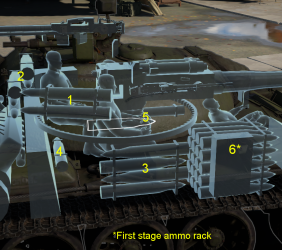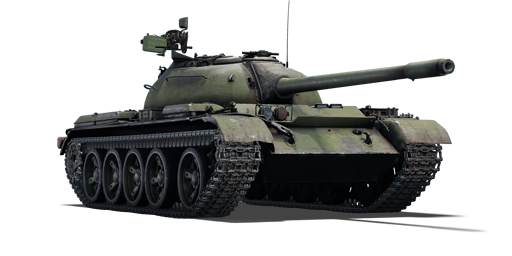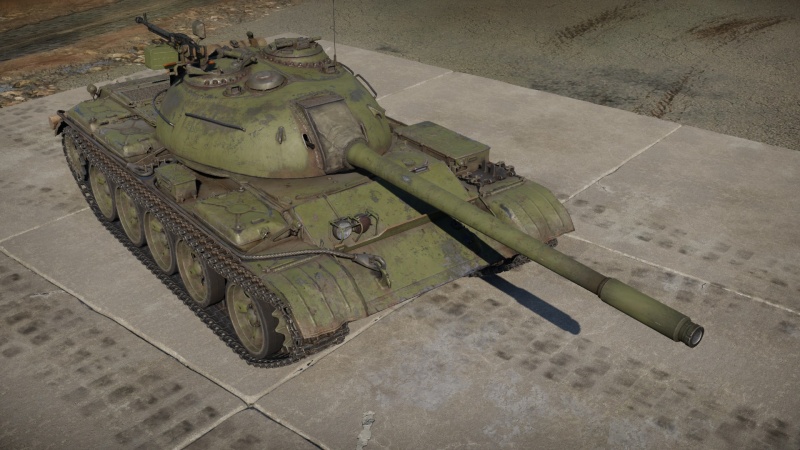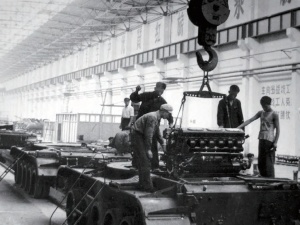Difference between revisions of "Type 59"
m (Corrected the timestamp on the video about the T-54/T-55 family.) (Tag: Visual edit) |
Colok76286 (talk | contribs) (Edited About template) |
||
| (2 intermediate revisions by 2 users not shown) | |||
| Line 1: | Line 1: | ||
| + | {{About | ||
| + | | about = Chinese medium tank '''{{PAGENAME}}''' | ||
| + | | usage = other uses | ||
| + | | link = Type 59 (Disambiguation) | ||
| + | }} | ||
{{Specs-Card | {{Specs-Card | ||
|code=cn_type_59 | |code=cn_type_59 | ||
| Line 205: | Line 210: | ||
;Videos | ;Videos | ||
| − | {{Youtube-gallery|sVCOipttDmg|'''The Shooting Range #265''' - ''Metal Beasts'' section at 00:27 discusses the {{PAGENAME}}.|B6ZsuPjSuNo|'''T-54/T-55 family''' discusses the {{PAGENAME}} at | + | {{Youtube-gallery|sVCOipttDmg|'''The Shooting Range #265''' - ''Metal Beasts'' section at 00:27 discusses the {{PAGENAME}}.|B6ZsuPjSuNo|'''T-54/T-55 family''' discusses the {{PAGENAME}} at 4:41 - ''War Thunder Official Channel''|-NsXtlGCC1g|'''Type 59 - Calm Aggression''' - ''Napalmratte''}} |
== See also == | == See also == | ||
Latest revision as of 04:52, 3 June 2024
| This page is about the Chinese medium tank Type 59. For other uses, see Type 59 (Disambiguation). |
Contents
Description
The Type 59 (Chinese: [ZTZ]59式中型坦克; industry code WZ120) is a rank V Chinese medium tank with a battle rating of 8.0 (AB/RB/SB). It was introduced in Update 1.91 "Night Vision" alongside the initial Chinese tech-tree.
Production of the Type 59, a licence-built Soviet T-54A (Ob'yekt 137G), started in 1958 and was the first domestically produced medium tank in the People's Republic of China and the cornerstone of the PLAGF for more than 4 decades. Although there were plans to build a domestic T-34-85, with all necessary parts ready for production, the Project 156 and the subsequent transfer of the T-54A's schematics put an end to these plans. The newly built Factory 617 (now NORINCO Inner Mongolia First Machinery Works) assembled 32 T-54As from CKD parts while they were producing the required parts for what would be known as the Type 59 after the year of its certification. Due to the Sino-Soviet split, the People's Republic of China had to wait another few years to truly start mass production of the tank with completely domestic parts; these tanks subsequently received different upgrades including a new FCS and main cannon in the 1980s, a further modernization in the 1990s improved protection. The Type 59s were eventually replaced by new domestic tanks during the first 20 years of the 21st Century, and now serve as reserve tanks or shooting-range targets for new PLAGF weapons.
It is a famous part of the PLA's Cold War tank inventory, saw service with many countries, and set the stage for many later developments. While basically a licence‑produced version of the Soviet T-54A, in part because of the simplified construction, the Type 59 looks very much like the T-54 (1951). The most noticeable differences are the fume extractor at the tip of the gun barrel and the different road wheels, similar to the T-55A. Internally, the Type 59 differs from the T-54 by having a single-plane stabilizer and a different ammunition selection.
It helps to get accustomed to this grandfather of Chinese tanks, as the later Type 69, ZTZ59D1, and T-69 II G are its descendants and handle similarly.
Succeeding the Type 59 is the Type 69, which improves on the Type 59 in many areas except its new, yet disappointing smoothbore cannon.
General info
Survivability and armour
The armour layout of the Type 59 is identical to the T-54 (1951), having a rounded, egg-shaped turret with a highly sloped upper glacis. The armour is not bad per se, but most of its opponents use powerful APDS, APFSDS, or HEATFS rounds that can go right through it. While it is mostly immune to APHE rounds from the front, few vehicles use them at its rank. The full-calibre AP shots fired by the M103's 120 mm gun can penetrate the Type 59's hull armour quite easily. However, the Type 59 is very resistant to autocannon fire. Most infantry fighting vehicles will not be able to penetrate its frontal armour, and the hull's 80 mm strong sides can block many APDS rounds if fired from a certain distance and angle.
Post-penetration survivability is doubtful. The ammunition is scattered throughout the tank and none of the ammunition racks are well protected. The interior of the tank is cramped and penetrating hits are likely to take out multiple crew members. When the gun is pointed forward, the driver, gunner, and commander are all lined up for an easy one-shot kill.
Armour type:
- Rolled homogeneous armour (Hull, Turret roof)
- Cast homogeneous armour (Turret, Gun mantlet)
| Armour | Front | Sides | Rear | Roof |
|---|---|---|---|---|
| Hull | 100 mm (60°) Front glacis 100 mm (54°) Lower glacis |
80 mm | 45 mm (16°) Upper 30 mm (72°) Lower |
30 mm Front 20 mm Back |
| Turret | 160 mm (14-39°) Turret front 200 mm (4-78°) Gun mantlet |
115 mm (45-50°) Upper 155 mm (10-30°) Lower |
65 mm (9-35°) | 30 mm |
Notes:
- Suspensions wheels and tracks are 20 mm thick
Mobility
| Game Mode | Max Speed (km/h) | Weight (tons) | Engine power (horsepower) | Power-to-weight ratio (hp/ton) | |||
|---|---|---|---|---|---|---|---|
| Forward | Reverse | Stock | Upgraded | Stock | Upgraded | ||
| Arcade | 56 | 9 | 36 | 806 | 992 | 22.39 | 27.56 |
| Realistic | 51 | 8 | 460 | 520 | 12.78 | 14.44 | |
The mobility of the Type 59 is the same as the T-54, above average but not excellent. While top speed will only be reached on paved surfaces, the wide tracks make for fairly good off-road capability. The tank cannot neutral steer and the reverse speed of -7 km/h leaves much to be desired. Speedy MBTs like the Leopard I will easily outrun the Type 59, though it can keep up with the M60 and is still faster than the Centurion Mk 10.
Modifications and economy
Armaments
Main armament
The Type 59 cannon is identical to the original Soviet D-10T used on the T-54 (1951) aside from its stabilizer and different choice of ammunition. The turret rotation speed is very slow, making it hard to respond to ambushes and fighting in close quarters. The vertical stabilizer allows the Type 59 to shoot accurately when driving under 40 km/h. The reload is quite slow, the average medium tank at the Type 59's battle rating will reload around 2 seconds quicker.
| 100 mm Type 59 | Turret rotation speed (°/s) | Reloading rate (seconds) | |||||||||||
|---|---|---|---|---|---|---|---|---|---|---|---|---|---|
| Mode | Capacity | Vertical | Horizontal | Stabilizer | Stock | Upgraded | Full | Expert | Aced | Stock | Full | Expert | Aced |
| Arcade | 34 | -5°/+18° | ±180° | Vertical | 9.5 | 13.2 | 16.0 | 17.7 | 18.8 | 9.75 | 8.62 | 7.95 | 7.50 |
| Realistic | 5.9 | 7.0 | 8.5 | 9.4 | 10.0 | ||||||||
Ammunition
| Penetration statistics | |||||||
|---|---|---|---|---|---|---|---|
| Ammunition | Type of warhead |
Penetration @ 0° Angle of Attack (mm) | |||||
| 10 m | 100 m | 500 m | 1,000 m | 1,500 m | 2,000 m | ||
| BR-412 | APHE | 218 | 212 | 189 | 164 | 142 | 124 |
| BR-412B | APHEBC | 218 | 215 | 201 | 184 | 169 | 155 |
| BR-412D | APCBC | 239 | 236 | 220 | 202 | 185 | 170 |
| BR-412P | APCR | 224 | 216 | 186 | 153 | 127 | 105 |
| Type 59 APDS | APDS | 361 | 356 | 335 | 311 | 288 | 267 |
| Type 1973 HEAT-FS | HEATFS | 390 | 390 | 390 | 390 | 390 | 390 |
| OF-412 | HE | 27 | 27 | 26 | 24 | 23 | 21 |
| Shell details | ||||||||||||
|---|---|---|---|---|---|---|---|---|---|---|---|---|
| Ammunition | Type of warhead |
Velocity (m/s) |
Projectile mass (kg) |
Fuse delay (m) |
Fuse sensitivity (mm) |
Explosive mass (TNT equivalent) (g) |
Ricochet | |||||
| 0% | 50% | 100% | ||||||||||
| BR-412 | APHE | 895 | 15.88 | 1.2 | 19 | 100.1 | 47° | 60° | 65° | |||
| BR-412B | APHEBC | 895 | 15.88 | 1.2 | 19 | 100.1 | 48° | 63° | 71° | |||
| BR-412D | APCBC | 887 | 15.88 | 1.2 | 19 | 100.1 | 48° | 63° | 71° | |||
| BR-412P | APCR | 1,050 | 8.53 | - | - | - | 66° | 70° | 72° | |||
| Type 59 APDS | APDS | 1,432 | 3.18 | - | - | - | 75° | 78° | 80° | |||
| Type 1973 HEAT-FS | HEATFS | 1,000 | 10.05 | 0.05 | 0.1 | 1,180 | 65° | 72° | 77° | |||
| OF-412 | HE | 900 | 15.6 | 0.2 | 0.1 | 1,460 | 79° | 80° | 81° | |||
The Type 59 has many ammunition types to choose from. The stock round is the BR-412 APHE. An uncapped shell, its performance is rather substandard for its rank, and it might have difficulties against angled armour or at long distances. The BR-412B APHEBC round is slightly better at a distance, and the BR-412D APCBC round is the best of the AP shells overall. These shells are best used against lightly armoured tanks like the Leopard I, which can be knocked out in a single shot. Light tanks and SPAAs are also good targets, but some may have extremely thin armour that will not trigger the fuse.
The BR-412P APCR shell is currently modelled as having less penetration than the BR-412D round, so it is completely useless and should not be taken.
The Type 1959 is a hard-alloy APDS with a compact nose pad, giving it superior flat penetration and inferior angled penetration in comparison to the 3BM8, which has a heavy tungsten alloy penetrator and a wide nose pad. 361 mm of flat penetration at point-blank is quite impressive, but with only slightly over 100 mm of 60° penetration, it will have difficulties penetrating the hull armour of heavy tanks, or even other members of the T-54 family if they are slightly angled. The APDS is a sound projectile with a high muzzle velocity and is well suited for medium to long-range engagements. Most tanks can be disabled by firing at their turrets or gun mantlets, and they can be destroyed with other projectiles if necessary.
The Type 1973 HEAT-FS has the same penetration as the T-55A's 3BK-5M HEATFS round. The muzzle velocity and weight are between the 3BK-5M and 3BK-5, but it has about 260 fewer grams of TNT equivalent due to the different filler. In practice, there is not a significant difference, and the HEAT-FS boasts the highest penetration out of all the Type 59's rounds, going clean through almost any tank not equipped with composite armour or ERA. It is also capable of triggering overpressure on light tanks and SPAAs occasionally. Unfortunately, the fuse is very sensitive and will trigger on bushes and fences.
The OF-412 HE shell only has 26 mm of penetration and is of limited use. It is not large enough to cause any notable damage to MBTs, and while it can cause overpressure damage, so can the HEATFS.
Note that the Type 59 does not have access to the 3D3 smoke shell from the T-54 (1951).
Ammo racks

| Full ammo |
1st rack empty |
2nd rack empty |
3rd rack empty |
4th rack empty |
5th rack empty |
6th rack empty |
Visual discrepancy |
|---|---|---|---|---|---|---|---|
| 34 | 33 (+1) | 28 (+6) | 24 (+10) | 23 (+11) | 21 (+13) | 1 (+33) | No |
Notes:
- Shells are modelled individually and disappear after having been shot or loaded.
- Rack 6 is a first stage ammo rack. It totals 20 shells and gets filled first when loading up the tank.
- This rack is also emptied early: the rack depletion order at full capacity is 6 - 1 - 2 - etc. until 5.
- Full reload speed will be realized as long as shells are available in the ready rack 6. If the ready rack is empty, a penalty to reload speed will occur.
- Simply not firing when the gun is loaded will move ammo from racks 1-5 into rack 6. Firing will interrupt the restocking of the ready rack.
- If you pack 28 (+6) shells, it will keep the turret empty of ammo.
- If you pack 21 (+13) shells, it will keep most of the hull empty of ammo.
The ammunition storage of the Type 59 is not exactly fail-safe, but this is true for many contemporary tanks. Spare ammunition is scattered around the turret and fighting compartment, and there is a large rack next to the driver. It is most sensible to not be carrying the maximum possible amount of ammunition in order to at least keep the turret empty. If 21 rounds or fewer are carried along, the fighting compartment will be emptied except for the first stage ammo rack, which helps to ensure that shots into the side are not immediately fatal.
Machine guns
| 12.7 mm Type 54 | ||||
|---|---|---|---|---|
| Mount | Capacity (Belt) | Fire rate | Vertical | Horizontal |
| Pintle | 500 (50) | 600 | -4°/+82° | ±180° |
| 7.62 mm Type 59 | ||||
|---|---|---|---|---|
| Mount | Capacity (Belt) | Fire rate | Vertical | Horizontal |
| Coaxial | 3,000 (250) | 600 | - | - |
Usage in battles
The Type 59 is best used similarly to the original T-54. The vehicle's mobility is decent, but the turret's rotation speed and the gun's inclination's velocity are really bothering. For those not used to this vehicle, it is better not to rush straight into the combat zone. Instead, stay behind other teammates, keep an eye on the surroundings, and anticipate where enemies may appear. The vertical stabilizer, an oddity for a high-tier vehicle, is effective up to around 40 km/h, which is a major step up from the familiar vertical stabilizers used by the M4 Sherman family and practically equivalent to two-plane stabilizer under most circumstances since the Type 59 will typically only exceed 40 km/h when driving downhill or on roads. Still, the mediocre gun handling makes high-speed shooting risky, since the turret will struggle with the rapid aim adjustments required. The stabilizer is a significant advantage when fighting unstabilized tanks, since the gun does not need to settle before an accurate shot. The gun should be kept pointed towards possible enemy positions and when rapid adjustments in aim are needed, both the hull and the turret should be turned.
Helicopters start to become common around the Type 59's battle rating and can be a major threat if equipped with rockets or ATGMs. The Type 59 has limited options for offence or defence against helicopters since it has poor gun handling and no smoke grenades. The APDS may possess the capability to eliminate helicopter pilots who exhibit inattention under the right circumstances. If they get closer, the heavy machine gun may be able to destroy or scare off unarmoured helicopters. If all else fails, shelter should be sought behind buildings or among trees.
The slow reload speed, poor gun control, and the presence of more manoeuvrable adversaries on the battlefield necessitate coordination with the team. It helps to bind the cupola mounted heavy machine gun to a separate key, the Type 54 HMG rotates fairly quickly and will rip through the sides of light targets like the AUBL/74 HVG with ease. If a healthy distance is maintained, the Type 59 has an easier time coping with its poor gun handling.
Attention should be paid to the battlefield to identify enemy tanks ahead of time, this facilitates the positioning of the main weapon and the selection of the appropriate ammunition. Thinly armoured enemies should typically be targeted with the APCBC round. It is worth remembering that although the OF-40, STB-1, and Leopard A1A1 look very similar to the Leopard I, they are significantly more resistant to conventional rounds from the front. If possible, the OF-40 should be shot in the lower, the STB-1 in the upper glacis (close to the turret ring or gun mantlet), and the A1A1 in the hull.
Tanks with good protection as often seen in the US, British, and Soviet models should be dealt with using APDS or HEATFS if side shots are not possible. HEATFS is typically the better option since it has higher penetration (enough to comfortably deal with Chieftain turrets where the APDS would struggle), but APDS is easier to aim at long distances (especially important since the Type 59 has no dedicated rangefinder) and cannot be stopped by ERA. It is advisable to take some of both into battle, perhaps more APDS on large maps. If possible, the gun should be aimed at crew members and ammo racks when using these ammunition types.
This basic version of the Type 59 omitted the night vision systems from the T-54A, so it must rely on illumination flares for vision in night battles. The Type 69 is much more self-sufficient in this regard, so consider using that tank first if it is present in the line-up.
Pros and cons
Pros:
- Powerful 100 mm gun with similarly wide selection of ammunition as the Soviet T-54 (1951), including strong HEATFS and high-velocity APDS
- Good frontal armour, strong against AP and APHE rounds
- Has a top-mounted heavy machine gun for use against soft targets and aircraft
- Decent vertical stabiliser, it only stops working at speeds over 40 km/h, speeds that are rarely reached
- Decent mobility
- APHE is reliably and devastatingly effective against lightly armoured vehicles like the Leopard I from the front and other tanks from the side
Cons:
- Long reload
- Sluggish turret traverse
- Armour does not hold up very well at its rank; APDS, HEATFS and APFSDS cut through the Type 59s armour, even at a distance
- No possibility for battlefield obscuration
- No night vision
- No neutral steering
- No laser or optical rangefinder, making long-range sniping more difficult
- Poor gun depression of -4°
- Not too impressive reverse of -7 km/h
History
During the early 1950s, the People's Republic of China purchased numerous tanks from the Soviet Union, such as the T-34-85 and the IS-2. Domestic industrial and engineering capabilities were quite limited at the time, and the USSR agreed to assist in setting up a factory manufacturing the T-54A in China. The Chinese versions were designated Type 59 and featured several differences from the original T-54A, such as the deletion of the night vision and possibly stabilizer systems, at least initially.
The Type 59 was produced for a long period of time in numerous versions, finally appearing in large numbers to completely replace the highly obsolete T-34-85 after a few decades. Though the Type 59 was initially a competitive design, it became apparent that it required some upgrades after a few years. An effort to create a replacement resulted in the Type 69, but this model was not very popular with the PLA, only seeing limited domestic service. As a result, the Type 59 remained the premier tank of the PLA for most of the Cold War, seeing usage in the Sino-Vietnamese War in 1979 and the unrest of 1989 while receiving limited domestic upgrades to the fire-control, automotive, and fire suppression systems. The reason for the PLA's continued use of this first generation MBT was largely due to the political turmoil that was happening in China during the late 60s and early 70s. Efforts to produce indigenous second-generation main battle tanks to replace the Type 59, such as the WZ-122, were generally stymied. These projects, which were to be carried out by experienced Chinese engineers, did not come to fruition for domestic political reasons.
When economic relations with the Western World began to tighten during the 1980s, foreign technologies became available for integration, resulting in numerous upgraded variants like the Type-59-II, Type 59D1, Type 59D, Jaguar, and VT-3. Soon afterwards, domestic tank development accelerated and the Type 59 was superseded by more modern tanks such as the Type 80/88 series. Currently, the Type 59 is still present in the PLA's inventory in sizable quantities but has been gradually relegated to reserve and training purposes, with more and more units being equipped with modern Type 96 and Type 99 main battle tanks.
Like the original T-54/55 series, the Type 59 was a popular export item. It was used by the North Vietnamese Army during the Vietnam War alongside its Soviet counterpart. It remains in use in countries such as Bangladesh, Pakistan, and Iran, often in a heavily upgraded form. Chinese companies still offer comprehensive upgrades and conversions of the Type 59 for export customers. An estimated 10,000 tanks were produced between 1959 to the 1980s.
Media
- Skins
- Videos
See also
- Related development
External links
- [Wikipedia] Type 59 tank
- [Tank Encyclopedia] Type 59 main battle tank
- [Federation of American Scientists - Military Analysis Network] Type 59
| Norinco (China North Industries Corporation) | |
|---|---|
| Light AFV/IFV | |
| WZ501 | ZBD86¹ |
| WZ131 | ▂Type 62 · Type 62 |
| WZ211 | Type 63 · ZTS63 |
| WZ502 | ZBD04A |
| MBT | |
| WZ120 | Type 59¹ · ZTZ59A · ZTZ59D1 |
| WZ121 | Type 69 |
| WZ122 | ZTZ88B · ZTZ88A · ZTZ96 · ZTZ96A · ZTZ96A (P) |
| WZ123 | ZTZ99-II · ZTZ99-III |
| WZ1001 | WZ1001(E) LCT · ZTZ99A |
| Tank Destroyers | AFT09 · PTL02 · PTZ89 · ZLT11 |
| SPH | PLZ83 |
| SPAA | ZSD63/PG87² · PGZ09 · PGZ04A |
| Export | |
| WZ121 | Type 69-IIa · T-69 II G |
| MBT2000 | MBT-2000 · Al-Khalid-I |
| MBT3000 | VT4A1 |
| Other | WMA301 · WZ305 |
| ¹ License production / Reverse engineered · ² Field modifications | |
| China medium tanks | |
|---|---|
| ZTZ59 | Type 59 · ZTZ59A · ZTZ59D1 |
| ZTZ69 | Type 69 · Type 69-IIa |
| ZTZ88/96 | ZTZ88A · ZTZ88B |
| ZTZ96 · ZTZ96A · ZTZ96A (P) | |
| ZTZ99 | ZTZ99-II · ZTZ99-III |
| ZTZ99A | ZTZ99A · WZ1001(E) LCT |
| Export series | MBT-2000 · VT4A1 |
| ROC | CM11 |
| Other | Т-34-85 Gai · Object 122MT "MC" |
| Bangladesh | T-69 II G |
| Japan | ␗Chi-Ha · ␗Chi-Ha Kai |
| Pakistan | Al-Khalid-I |
| USA | ␗M4A4 · ␗M4A4 (1st PTG) · ␗M4A1 (75) W · ␗M48A1 · ␗M60A3 TTS |
| USSR | ␗T-34 (1943) · ␗Т-34-85 (S-53) · T-34-85 No.215 · Т-62 №545 |






